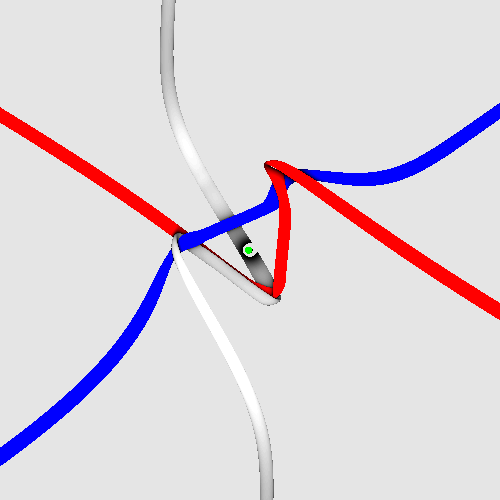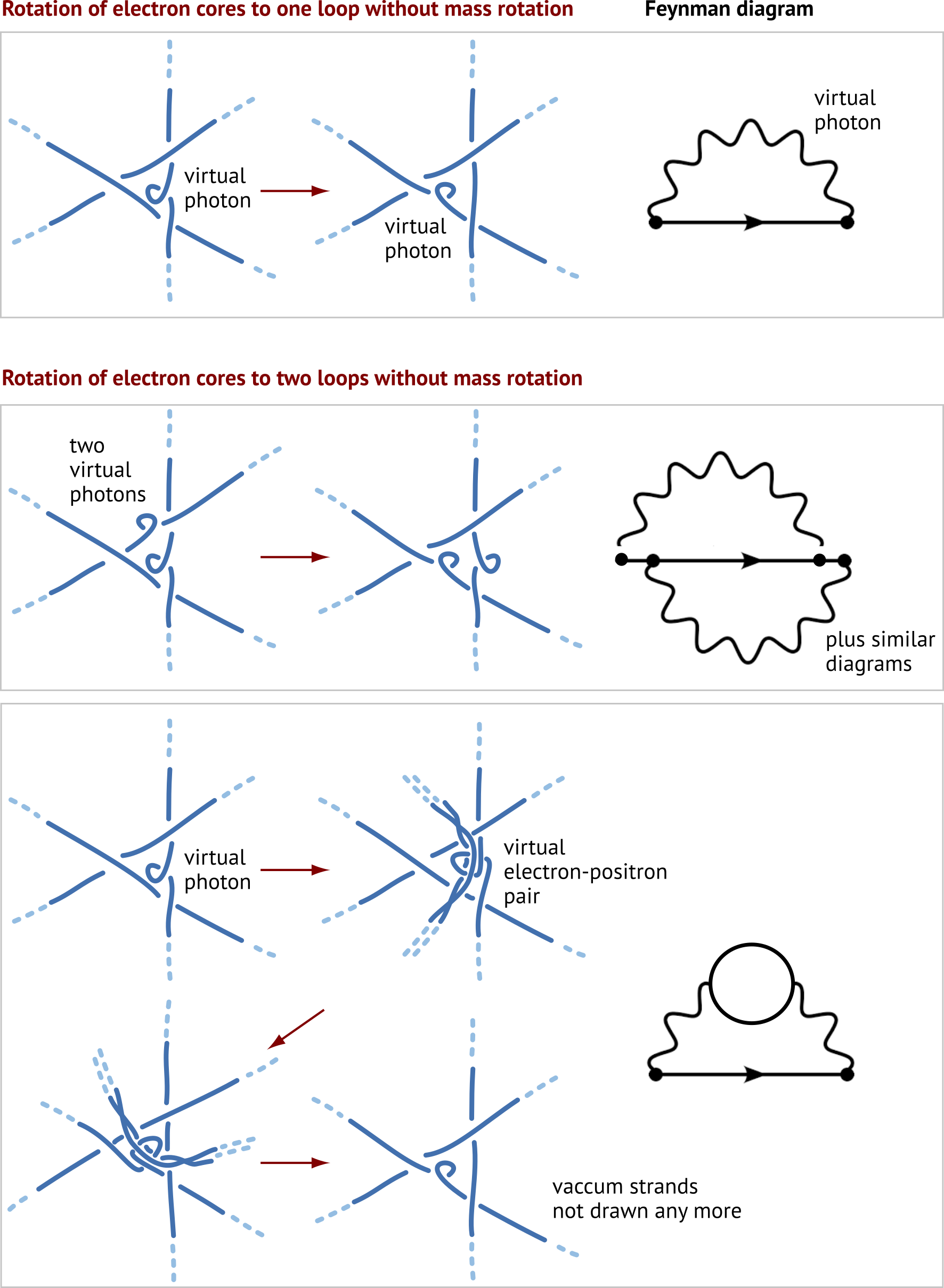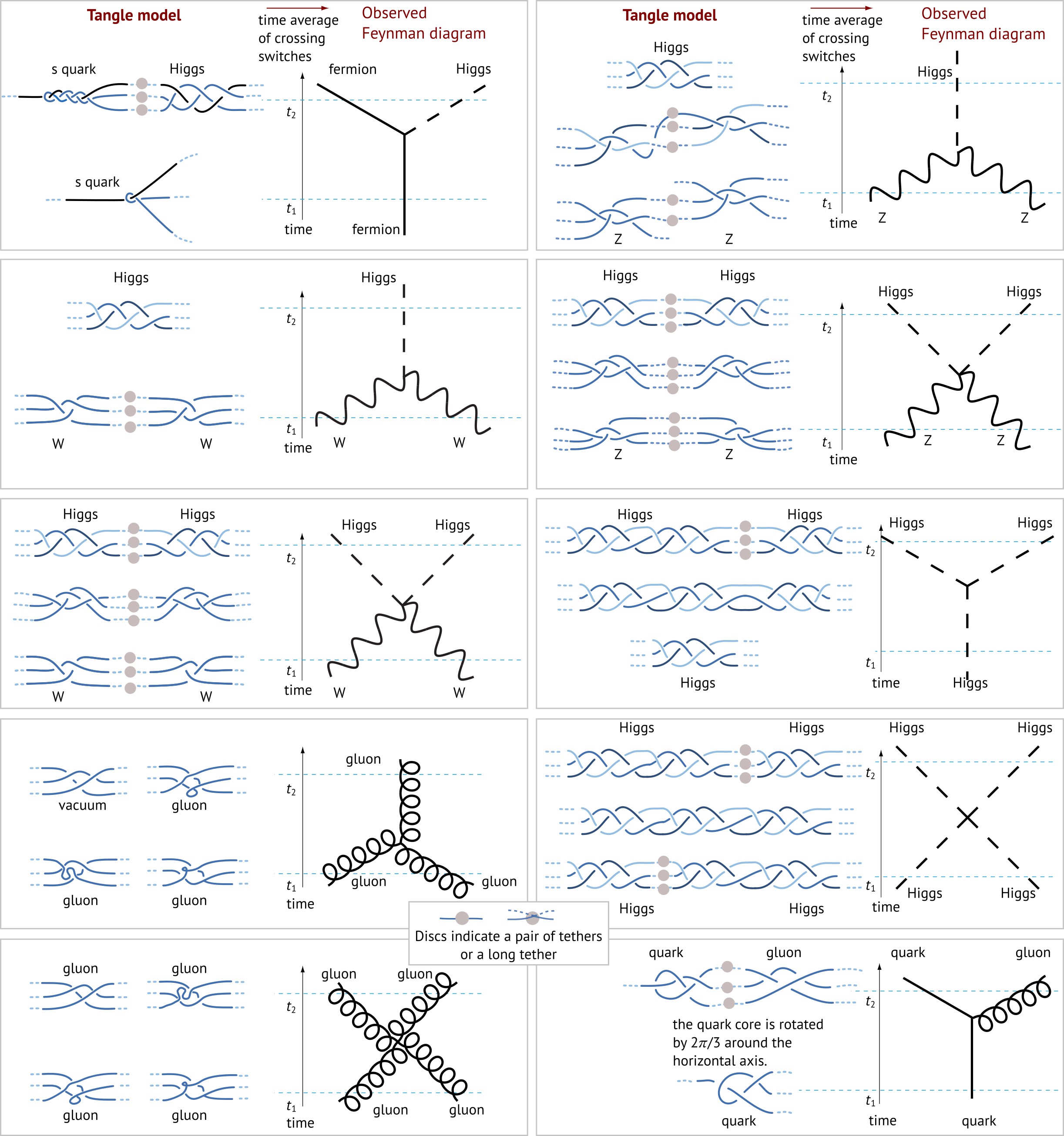
Particle physics, including QED, follows from tangled strands.
Tangled strands explain the origin of wave functions and quantum fields, as explained in this text that forms the basis for the following. Tangles explain, for each elementary particle, its origin, its quantum numbers, and its generation. Tangles explain the origin and the Lie groups of the three gauge interactions. Tangles explain the Lagrangian of the standard model and quantum electrodynamics, as shown in the figures below, and also in this publication.
Tangled strands explain the Higgs mechanism, the symmetry breaking of SU(2) and its maximum parity violation. Tangled strands explain the quark model. Tangled strands explain the origin of every Feynman vertex and thus of the Lagrangian of the standard model with massive neutrinos. Tangled strands explain the origin of the fundamental constants: particle masses, coupling constants and mixing angles. The numerous experimental predictions and consequences, listed here, agree with every experiment ever conducted.
Because no other approach in the literature provides all these results, it makes sense to calculate the fundamental constants from tangles and their shapes.
The value of each coupling constant is due to the amplitudes for gauge boson emission or absorption. In particular, photons are first Reidemeister moves: photons are twists. Electric charges emit twists. Therefore, electric charge is due to tangle chirality.
The mass value of particles describe the coupling of rotation and propagation. Therefore, also particle masses are due to tangle chirality. (The Higgs coupling is also reproduced but is left for a later stage of the investigation.)
At least two mathematical ways to quantify the chirality of tangles are thus
needed. This is a general mathematical challenge. More exactly, this
general challenge yields several specific challenges about knot and tangle
geometry.
The electron tangle
For an electron at rest, all six tethers leave along the coordinate axes.

For an electron moving towards the reader, spinning motion is depicted here (with some minor errors):

In other terms, the value of the electron mass describes the intensity
of the propeller effect of its tangle core. If a fluid flows
perpendicularly through the paper plane with speed v, how fast does the
tangle with its strands with Planck radius rotate? If you have a
suggestion on how to estimate the angular velocity resulting from a speed
v, I'd be interested to hear from you at christoph@motionmountain.net.
I offer a prize for any good hint and will publish a paper with you.
Mathematical challenges and prizes
1. Is the 3d writhe of tight alternating rational tangles with a few crossings quantized and if so, what is the value of the 3d writhe quantum? (For tight alternating knots with a few crossings, the 3d writhe is quantized in multiples of 1/7.) See the pictures below for the precise tangles that are meant. I offer 200 Euro for an answer. (Literature on the writhe of knots is found here.)
2. Is there a good analytical approximation to the shape of the tight electron tangle with radius 1? (See the figures below.) I offer 200 Euro for an answer. There is no prize for an exact solution because an exact solution is highly unlikely: you will win almost every prize that exists in mathematics if you find it. What is the size of the inner triangle for the three charged leptons with unit strand radius? I offer 50 Euro for an answer.
3. How can the "wind chirality" defined in arxiv.org/2004.10338 be approximated precisely for tight tangles? (Note that wind chirality depends on the direction.) More challenges are listed in the figure below. I offer a prize for each answer.
4. Is there a "twist chirality" that explains the probability of twist emission or absorption? I offer 200 Euro for an answer. Twist chirality should measure the twistiness of a tangle, separately for each direction in space. (If needed, I can provide more details via mail.)
5. Do 3d writhe, wind chirality, or some similar quantities change (roughly) logarithmically with the flattening of the tether frame, i.e., with the flattening of the 6 tethers keeping the lepton localized? I offer 200 Euro for a positive answer with proof. Less for a negative answer.
6. Does a tight flat electron tangle, with all its tethers in a plane, exist? (Or is there only a tight one for almost flat tangles?) What is its shape? I offer a prize for each answer.
7. What is the 3d writhe of the flat (or almost flat) electron tangle? Its wind chirality? Its twist chirality? And for the muon and tau tangles? I offer a prize for each answer.
A few additional mathematical prizes are found on the prize page. All prizes are for the first solution sent in.
Overview of puzzles

Fermion tangles

Boson tangles
From tangles to quantum electrodynamics

From tangles to other Feynman diagrams

From tangles to g-factor diagrams

The Feynman vertices of the standard model


The origin of wave functions from tangles

Wave functions are blurred tangles.
Wave functions are crossing densities of tangles.
Tangles are skeletons of wave functions.
See this
pedagogical text for the detailed proof.

Quantum field theory arises exactly if the strands are approximated to have zero radius. But in this case, mass and couplings have to be added by hand. If the Planck radius of the strands is taken into account, quantum field theory still arises, but the mass and the couplings can be calculated.
From strands to quantum field theory
In the tangle model, strands by themselves are not observable. Only switches of crossings are observable. Particles are rotating tangles of strands. Only their tangled region is thus observable.
The rational 3d tangles describing particles also describe antiparticles, reactions, interactionas and decay. And they yield spinor wave functions as their crossing densities.
If one imagines that strands have zero radius and that tangles are pointlike, one gets pure quantum field theory. However, in this case, particle masses and coupling constants cannot be calculated but must be introduced by hand.
For strands of Planck radius, there are deviations at Planck scales. These are unmeasurable. However, particle masses and coupling constants can be calculated.
Literature
C. Cerf and A. Stasiak. A topological invariant to predict the three-dimensional writhe of ideal configurations of knots and links. Proceedings of the National Academy of Sciences, 97 (2000) 3795–3798.
P. Hoidn, R.B. Kusner, and A. Stasiak, Quantization of energy and writhe in self-repelling knots, New Journal of Physics 4 (2002) 20.
E.L. Altschuler, Why the 3d writhe of ideal knots and links is quantized and additive, arxiv.org/physics/0102081.
A. Klotz, C.J. Anderson, Ropelength and writhe quantization of 12-crossing knots, arxiv.org/2305.17204.
G. Dietler, R. Kusner, W. Kusner, E. Rawdon, P. Szymczak, Chirality for crooked curves, arxiv.org/2004.10338.